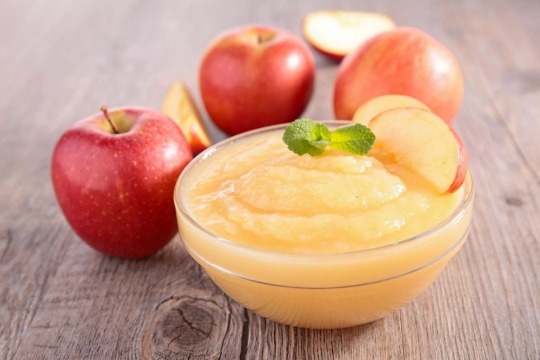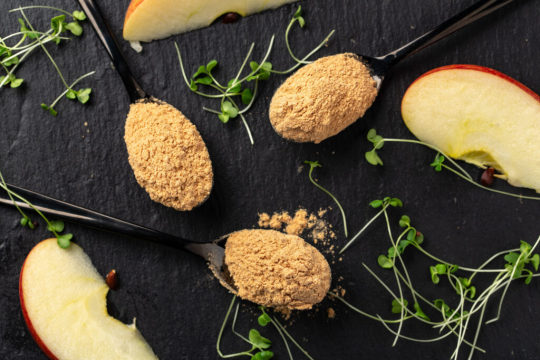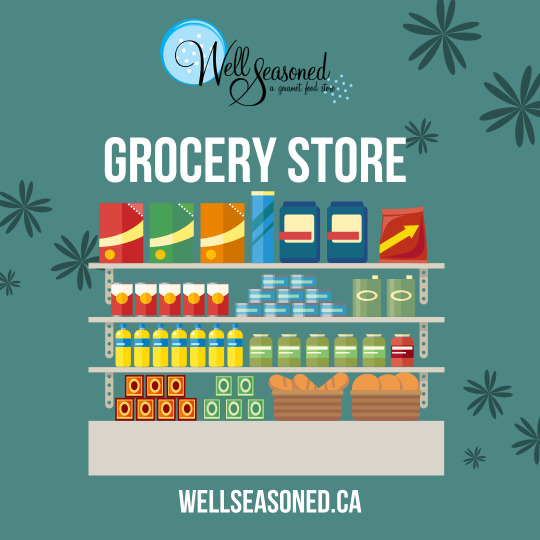Text
Apple Sauce Market Projected to Show Strong Growth

Advance Market Analytics published a new research publication on "Apple Sauce Market Insights, to 2028" with 232 pages and enriched with self-explained Tables and charts in presentable format. In the Study you will find new evolving Trends, Drivers, Restraints, Opportunities generated by targeting market associated stakeholders. The growth of the Apple Sauce market was mainly driven by the increasing R&D spending across the world.
Get Free Exclusive PDF Sample Copy of This Research @ https://www.advancemarketanalytics.com/sample-report/179658-global-apple-sauce-market The Apple Sauce Market report covers extensive analysis of the key market players, along with their business overview, expansion plans, and strategies. The key players studied in the report include: The J.M. Smucker Company (United States), Dr Pepper Snapple Group (United States), Nestlé S.A. (Switzerland), Materne North America Corp. (United States), Knouse Foods Cooperative Inc. (United States), Burnette Foods, Inc. (United States), Charles & Alice SAS (France), Leahy Orchards Inc (Canada), Seneca Foods Corporation (United States), Del Monte Food, Inc. (United States). Definition: Apple sauce is prepared by cooking unpeeled apples with an apple beverage or water. For style improvement, a range of spices like cinnamon and sweetening and flavorings agents together with honey or sugar area unit additional into apple sauce. These products are offered in varied packaging choices like pouches, cups, jars, and cans. Apple sauce is made of a supply of vitamin C and fiber or cellulose. As a result, apple sauce is widely used in the treatment of diarrhea-like diseases. excluding this, apple sauce assists in minimizing the danger of many diseases like cancer and upset. It conjointly helps in up digestion and reducing cellular aging. The following fragment talks about the Apple Sauce market types, applications, End-Users, Deployment model etc. A thorough analysis of Apple Sauce Market Segmentation: by Type (Sweetened, Plain), Application (Salads, Desserts, Bakery products, Others), Nature (Organic, Conventional), Packaging (Bottle, Sachets, Pouches, Others) Apple Sauce Market Drivers:
Rising Demand for the Ready to Eat Foods
Increasing Demand for the Supplements with Different Foods for Snacks like Waffles, Granola
Apple Sauce Market Trends:
Clean Label Manufacturing and Innovating Recipes around Apple Sauce
Apple Sauce Market Growth Opportunities:
Increasing Premixes and Flavourings in Functional Foods in Fitness Industry
Rising Demand for the Organic Foods by Vegan Population
As the Apple Sauce market is becoming increasingly competitive, it has become imperative for businesses to keep a constant watch on their competitor strategies and other changing trends in the Apple Sauce market. Scope of Apple Sauce market intelligence has proliferated to include comprehensive analysis and analytics that can help revamp business models and projections to suit current business requirements. We help our customers settle on more intelligent choices to accomplish quick business development. Our strength lies in the unbeaten diversity of our global market research teams, innovative research methodologies, and unique perspective that merge seamlessly to offer customized solutions for your every business requirement. Have Any Questions Regarding Global Apple Sauce Market Report, Ask Our Experts@ https://www.advancemarketanalytics.com/enquiry-before-buy/179658-global-apple-sauce-market Strategic Points Covered in Table of Content of Global Apple Sauce Market:
Chapter 1: Introduction, market driving force product Objective of Study and Research Scope the Apple Sauce market
Chapter 2: Exclusive Summary and the basic information of the Apple Sauce Market.
Chapter 3: Displaying the Market Dynamics- Drivers, Trends and Challenges & Opportunities of the Apple Sauce
Chapter 4: Presenting the Apple Sauce Market Factor Analysis, Porters Five Forces, Supply/Value Chain, PESTEL analysis, Market Entropy, Patent/Trademark Analysis.
Chapter 5: Displaying the by Type, End User and Region/Country 2018-2022
Chapter 6: Evaluating the leading manufacturers of the Apple Sauce market which consists of its Competitive Landscape, Peer Group Analysis, BCG Matrix & Company Profile
Chapter 7: To evaluate the market by segments, by countries and by Manufacturers/Company with revenue share and sales by key countries in these various regions (2023-2028)
Chapter 8 & 9: Displaying the Appendix, Methodology and Data Source
Finally, Apple Sauce Market is a valuable source of guidance for individuals and companies. Read Detailed Index of full Research Study at @ https://www.advancemarketanalytics.com/reports/179658-global-apple-sauce-market What benefits does AMA research study is going to provide?
Latest industry influencing trends and development scenario
Open up New Markets
To Seize powerful market opportunities
Key decision in planning and to further expand market share
Identify Key Business Segments, Market proposition & Gap Analysis
Assisting in allocating marketing investments
Thanks for reading this article; you can also get individual chapter wise section or region wise report version like North America, Middle East, Africa, Europe or LATAM, Southeast Asia.
#Global Apple Sauce Market#Apple Sauce Market Demand#Apple Sauce Market Trends#Apple Sauce Market Analysis#Apple Sauce Market Growth#Apple Sauce Market Share#Apple Sauce Market Forecast#Apple Sauce Market Challenges
0 notes
Text
Breaking Down the Labels: Understanding Hot Sauce Ingredients
In the realm of culinary delight, hot sauce has secured its place as a versatile and flavorful condiment. As the demand for unique and bold flavors grows, it's crucial to understand the key components that make up this fiery concoction. In this blog post, we will break down the labels and delve into the intricacies of hot sauce ingredients, shedding light on what goes into crafting this beloved condiment. Whether you're a hot sauce enthusiast or a curious consumer, join us on a journey to unravel the mysteries behind your favorite spicy companion.

The Spice Evolution
Hot sauce, a culinary staple in many cultures, has evolved from being a mere condiment to a key ingredient that adds depth and character to a wide range of dishes. The surge in popularity of hot sauce has given rise to a diverse array of options on the market. From mild and tangy to explosively spicy, hot sauces cater to a spectrum of taste preferences.
Hot Sauce Ingredients: A Comprehensive Guide
1. Peppers – The Heart of the Heat
At the core of any hot sauce is the pepper – the primary source of heat and flavor. Various pepper varieties contribute to the unique profiles of different hot sauces. Common peppers used include jalapeños, habaneros, serranos, and Thai chilies. Each pepper brings its own distinct heat level, flavor nuances, and sometimes even fruity or smoky undertones.
2. Vinegar – The Tangy Twist
Vinegar plays a dual role in hot sauce, serving as a preservative and contributing a tangy kick. Distilled white vinegar, apple cider vinegar, and rice vinegar are popular choices among hot sauce manufacturers. The type of vinegar used can influence the overall flavor profile, with some hot sauces boasting a more pronounced tanginess.
3. Salt – Balancing Act
Salt is a crucial ingredient that not only enhances the overall flavor but also acts as a natural preservative. It helps balance the heat of the peppers and the acidity of the vinegar, creating a harmonious blend. Sea salt, kosher salt, or specialty salts can be used to add depth to the hot sauce's taste.
4. Sweeteners – Taming the Fire
To counteract the heat and acidity, many hot sauces incorporate sweeteners. Sugar, honey, or fruit juices are commonly used to add a touch of sweetness. This not only provides a more rounded flavor but also helps in mellowing out the intense heat, making the hot sauce approachable to a broader audience.
5. Garlic and Onion – A Flavorful Foundation
Garlic and onion are often included in hot sauce recipes to impart a savory and aromatic base. The subtle flavors of these ingredients complement the heat of the peppers, contributing to a well-rounded and complex taste profile. Roasted or raw, garlic and onion can add depth and richness to the hot sauce.
Hot Sauce Manufacturers in India: Crafting Culinary Excellence
In the vibrant landscape of hot sauce manufacturing, India has emerged as a hub for diverse and innovative flavors.�� Hot sauce manufacturers in India are known for infusing traditional spices and regional influences into their creations, offering a wide range of options for spice enthusiasts.
Private Labelling in Vadodara
For those looking to venture into the hot sauce market with their unique twist, private labeling companies in Vadodara provide a valuable service. These companies specialize in creating customized hot sauce formulations and packaging, allowing businesses to establish their brand identity in the competitive market.
Hot Sauce Supplier in Kuwait: Global Spice Fusion
Kuwait, with its rich culinary traditions, has also embraced the global fascination with hot sauces. A hot sauce supplier in Kuwait bridges the gap between the diverse world of hot sauce manufacturing and the Kuwaiti consumer market. These suppliers ensure a steady flow of premium hot sauces, catering to the diverse taste preferences of the Kuwaiti population.
Conclusion
As we unravel the labels of hot sauce bottles, it becomes evident that this fiery condiment is a harmonious blend of heat, tanginess, sweetness, and savory undertones. Understanding the intricacies of hot sauce ingredients allows consumers to make informed choices based on their flavor preferences.
For those looking to explore the world of hot sauce beyond the typical offerings, the burgeoning hot sauce manufacturers in India, private labeling companies in Vadodara, and hot sauce suppliers in Kuwait open up exciting possibilities. Whether you prefer a milder tang or an explosive heat, hot sauce has something for everyone, making it a truly universal culinary delight.
#Hot sauce#Hot sauce manufacturers in India#Hot sauce supplier in Kuwait#Private labelling company#Hot sauce manufacturing companies in Vadodara#extracts#flavor#ketchup#canned foods#bottled items#Kitchen#business#restaurant#hotel#fast food#India#Kuwait
6 notes
·
View notes
Text
Garden Report & Frugal Living 23.09.22
It is getting chilly. In the predawn hours the temperatures drop enough to grab a jumper, shawl or vest. This morning I went out to see the stars (what you can see through the city's light pollution). The morning star was rising over the roof tops, a very twinkly red-orange-red and as it climbed the sky, it faded to a buttery yellow. We have a break in the fog because rain is on its way so need to consider what's in the garden to get in.
The tomatoes (cherry and pear) are technically done now that they have started to ripen. There will be no more pollination and no more new fruits to develop. Will bring in all those.
Some herbs can ride out the weather but are looking pretty sad at this time of year. Considering small batch harvests like mint. Could do more rose petals with the amount of roses. Have to harvest the wild rose hips before the soggy rain (will incorporate
Blackberries are starting to molding in the heavy fog/dew so need to be careful to do a second sort before tossing in the freezer. Fruit flies are hanging heavy as well. The yellow raspberries are so delicious, the faint taste of flowery apricots or a melon. They are not heavy bearing for our hungry family (I have a 2m row) but considering doing root propagation to multiple ... but as always: where to put them! I am actually considering ripping up a small paver patio and taking down the pergola . Right now it is a landing pad for construction material (new and salvaged) and other junk has come to roost as well. I have to reclaim it as freed space before I can come to a decision. The apples are in. I need to keep an eye on them as some are ripe, others are green and they are resting/mellowing in the cold dark dining room. I don't want apple slush slime/sweat to work into the rugs.
The winter garden is vexing me. Its warm enough in the day but the night chill literally puts a damper on them, even under cover. I think the box that is planted just isn't getting enough daylight hours even though it is planted with things that can take partial shade -- we just don't get heat (yeah, global warming :/ ). The low sun in the sky and tree line just might not be conducive to happy plants even on a 'sunny' day. The hops might be ready to harvest mid october but we will have to see about the rain -- its a no win if they are contaminated with molds.
It feels rather strange not to be doing canning. I have been putting things through the dehydrator but have to watch the electrical metre.
And my frugal tips for the day: 1) make sourdough starter. The breads, even the artisan types are using so much conditioners in their dough that you can take the finished product and mash it into wet dough balls. And the price of bread has doubled and for some markets, tripled in price. Carving out time to make dough and bake on my day off for less money and better nutritional toothsome bread. 2) I had made some chicken curry using boneless thighs enough (so I thought) for two nights. The chicken was so waterlogged that it was floating the meat and the sauce had turned to soup. The chicken was consumed in one meal (hungry kids) and lots of soupy sauce was left. Saved soupy sauce and the next night stirred some hamburger crumble into it, adding chopped onions, bell pepper and carrot to serve over rice. Double dipping on the sauce was a great option/second use of the mess. It was like reinventing leftovers that might have gone to waste.
#catholic gardener#garden report#frugal living#urban homesteading#permaculture#garden#gardening#harvest#baking#sourdough starter#recreating leftovers#recreating dinner disasters
4 notes
·
View notes
Text
Why Your Wholesale Business Needs Fresh Apricots: Bulk Buying Insights

In today’s aggressive marketplace, wholesale agencies have to constantly adapt and innovate to fulfill patron needs. Fresh apricots are one product that has garnered significant recognition. Sourcing apricots in bulk can cause good-sized profit margins and client pride. This article explores the benefits of incorporating sparkling apricots into your wholesale commercial enterprise, providing insights on where to buy products in bulk and how to leverage B2B wholesale websites effectively.
The Growing Demand for Fresh Apricots
Health Benefits of Apricots
Fresh apricots are not only delicious but also packed with health benefits. Fresh apricots are abundant in vitamins A and C, potassium, and essential fiber. This nutritional profile appeals to health-conscious customers, making apricots a first-rate addition to your wholesale services. By presenting fresh apricots, you cater to the developing demand for wholesome snacks and components, improving your product variety.
Versatile Usage in Culinary Applications
Apricots have a wide range of culinary applications, ranging from salads and smoothies to desserts and sauces. This versatility makes them appealing to an extensive variety of customers, which includes restaurants, cafes, and retail grocery shops. By sourcing sparkling apricots in bulk, you can tap distinctive markets and meet various purchaser needs.
Advantages of Buying Fresh Apricots in Bulk
Cost-Effectiveness
One of the maximum benefits of purchasing products in bulk is cost-effectiveness. Buying sparkling apricots in larger portions often results in lower prices per unit. This fee reduction allows you to maintain competitive pricing while maximizing your profit margins. Furthermore, bulk buying minimizes the frequency of orders, lowering shipping costs and logistics challenges.
Improved Supply Chain Efficiency
When you purchase apricots in bulk, you streamline your delivery chain. Instead of placing common orders, which can disrupt inventory management, bulk shopping ensures that you have a regular delivery of clean merchandise. This efficiency lets you fulfill purchaser needs without delays and reduces the threat of stockouts.
Enhanced Product Freshness
Freshness is important in relation to perishable goods like apples. Direct sourcing from providers in bulk ensures the harvest of goods at their peak ripeness and prompt delivery to your enterprise. This commitment to excellence can enhance customer satisfaction and encourage repeat business.
Where to Source Fresh Apricots
B2B Wholesale Websites
In the digital age, B2B wholesale websites have become essential tools for wholesale groups. These structures offer rights of entry to an extensive variety of providers and merchandise, making it easier to source clean apicots. Here are some top-notch B2B wholesale websites to keep in mind:
Global Trade Plaza: As a leading B2B marketplace, Global Trade Plaza connects wholesalers with depended-upon suppliers of fresh apples. The platform offers a user-friendly interface, permitting businesses to examine prices, view product specifications, and study dealer opinions.
Alibaba: Alibaba is regarded as one of the largest global B2B platforms, offering a wide variety of sparkling produce, including apricots. The platform permits you to talk directly with providers, negotiate prices, and arrange for bulk orders.
TradeIndia: This Indian B2B platform specializes in connecting nearby wholesalers with suppliers across various sectors. TradeIndia offers a committed segment for sparkling fruits, making it less difficult to discover first-class apricot suppliers.
Made-in-China: If you’re searching out apricot providers from China, Made-in-China is a tremendously useful resource. This platform lists multiple suppliers, permitting you to compare fees and product offerings.
Local Wholesale Distributors
While B2B websites are useful, it's important not to overlook the pricing of local wholesale vendors. Many regional suppliers concentrate on a clean end result and can offer you apricots sourced from local farms. Building relationships with those vendors can lead to better pricing, advanced delivery instances, and a dependable supply of excellent merchandise.
Tips for Successfully Sourcing Fresh Avocados
Establish clear specifications
Establishing clear specifications regarding satisfaction, length, and ripeness is crucial when sourcing fresh apricots. Communicating your requirements to providers guarantees that you receive merchandise that meets your standards. This clarity reduces the risk of receiving inferior-quality apricots, thereby enhancing your market recognition.
Conduct Supplier Research
Before setting bulk orders, conduct thorough research on potential suppliers. Read evaluations, ask for references, and check their certifications to make certain they meet food protection standards. Reliable suppliers will have an established track record of consistently turning in fresh products.
Negotiate Terms
Don’t hesitate to barter phrases with suppliers. Discuss pricing, price options, and shipping schedules to steady the quality deal in your wholesale business. Building an excellent relationship with suppliers can ultimately lead to better terms.
Monitor Market Trends
Stay updated on marketplace traits related to clean produce, which includes apricots. Understanding client preferences and seasonal variations will enable you to adjust your purchasing strategies accordingly. For instance, the demand for apricots may increase throughout the summer months, allowing you to stock up earlier.
Conclusion
Incorporating fresh apricots into your wholesale business supplies can provide size able advantages, from more desirable consumer satisfaction to expanded earnings margins. By leveraging B2B wholesale websites and organizing relationships with reliable providers, you may supply super apricots in bulk correctly. Whether you’re a pro wholesaler or just beginning, the insights shared in this newsletter will assist you in making informed choices and thriving inside the aggressive wholesale market.
0 notes
Text
0 notes
Text
Apple Sauce Market Size is Projected to Reach USD 2.6 billion by 2031
The global apple sauce market is estimated to flourish at a CAGR of 3.4% from 2023 to 2031. Transparency Market Research projects that the overall sales revenue for apple sauce is estimated to reach US$ 2.6 billion by the end of the aforementioned period of assessment.
Emerging trends in apple sauce focus on varied textures, including chunky, smooth, and blended varieties, catering to diverse consumer preferences and culinary uses. Increasing consumer demands for transparency in ingredient sourcing, organic certifications, and minimal processing drive brands to emphasize clear labeling and clean ingredient lists.
Request to Sample PDF of this Strategic Report @ https://www.transparencymarketresearch.com/sample/sample.php?flag=S&rep_id=21134
Some prominent manufacturers are as follows:
Nestle S.A.
Dr Pepper Snapple Group
Materne North America Corp
Knouse Foods Cooperative Inc.
Burnette Foods, Inc.
Charles & Alice SAS
Leahy Orchards, Inc.
Seneca Foods Corporation
Del Monte Food, Inc.
White House Foods Company
Tree Top, Inc.
Manzana Products Co.
Solana Gold Organics
Santa Cruz Natural Incorporated
Cherry Central Cooperative, Inc.
Andros Group
The J.M. Smucker Company
A growing trend towards portion-controlled packaging, particularly in single-serve sachets or smaller jars, caters to on-the-go consumption and portion-conscious consumers seeking convenience. Brands explore the addition of functional ingredients like spices, superfoods, or probiotics to apple sauce, aligning with wellness and nutritional enhancement trends. Upscale offerings targeting discerning consumers with premium ingredients, unique flavors, or artisanal production methods aim to elevate the perception and value of apple sauce.
Key Findings of the Market Report
Organic nature segment leads the apple sauce market due to heightened consumer preference for natural, organic, and healthier options.
Sweetened apple sauce leads the market due to its popularity among consumers seeking a balance between sweetness and flavor preferences.
Jars lead the apple sauce market packaging segment due to their popularity, reliability, and widespread use for packaging apple sauce.
Apple Sauce Market Growth Drivers & Trends
Growing preference for natural, low-sugar, and additive-free options fuels the demand for apple sauce in health-focused diets.
Increasing consumer preference for convenient and healthy snacking options propels apple sauce market growth.
Introduction of diverse flavors and blends cater to evolving consumer tastes, expanding the apple sauce market.
Rising demand for eco-friendly and sustainable packaging solutions influences market trends and consumer choices.
Adoption of apple sauce in diverse cuisines and culinary applications aligns with worldwide health and wellness movements.
Apple Sauce Market: Competitive Landscape The apple sauce market thrives amidst robust competition, led by key players offering diverse apple-based products. Brands like Tree Top, Manzana Products Co., and Musselman's dominate, boasting superior quality and wide product portfolios.
Emerging contenders such as Materne North America (GoGo squeeZ) and Eden Foods contribute innovative packaging and organic offerings. Private labels from retailers like Walmart and Kroger intensify market dynamics, emphasizing affordability and variety.
Market rivalry hinges on product diversification, quality, sustainable practices, and consumer-centric innovations, fueling the race to cater to health-conscious consumers seeking natural, flavorful apple sauce options globally.
Apple Sauce Market: Key Segments
By Nature
Organic
Conventional
By Type
Sweetened
Unsweetened
By Packaging
Cups
Pouches
Cans
Jars
Others
By End Use
Food Industry
Bakery
Confectionery
Baby Food
Others
Household (Retail)
Food Services
Others
By Distribution Channel
Direct Channel
Indirect Channel
Hypermarket/Supermarket
Convenience Store
Discount Store
Food & Drink Specialty Store
Independent Small Grocery
Online Retail
By Region
North America
Latin America
Western Europe
Eastern Europe
South Asia
East Asia
Oceania
Middle East and Africa (MEA)
Buy this Premium Research Report: https://www.transparencymarketresearch.com/checkout.php?rep_id=21134<ype=S
About Transparency Market Research
Transparency Market Research, a global market research company registered at Wilmington, Delaware, United States, provides custom research and consulting services. Our exclusive blend of quantitative forecasting and trends analysis provides forward-looking insights for thousands of decision makers. Our experienced team of Analysts, Researchers, and Consultants use proprietary data sources and various tools & techniques to gather and analyses information.
Our data repository is continuously updated and revised by a team of research experts, so that it always reflects the latest trends and information. With a broad research and analysis capability, Transparency Market Research employs rigorous primary and secondary research techniques in developing distinctive data sets and research material for business reports.
Contact:
Transparency Market Research Inc.
CORPORATE HEADQUARTER DOWNTOWN,
1000 N. West Street,
Suite 1200, Wilmington, Delaware 19801 USA
Tel: +1-518-618-1030
USA – Canada Toll Free: 866-552-3453
Website: https://www.transparencymarketresearch.com
0 notes
Text
youtube
Exploring the Versatile Bok Choy: A Staple in Chinese Cuisine
Bok choy, also known as Chinese cabbage, is a beloved staple in Chinese cuisine, celebrated for its mild flavor, crunchy texture, and numerous health benefits. This versatile vegetable, with its vibrant green leaves and crisp white stalks, can be found in a variety of dishes, from stir-fries to soups. In this blog post, we will delve into the history, nutritional benefits, culinary uses, and tips for cooking with bok choy, highlighting why it deserves a prominent place in your kitchen.
A Brief History of Bok Choy
Bok choy, scientifically known as Brassica rapa subsp. chinensis, has been cultivated in China for over 1,500 years. Its name translates to "white vegetable" in Cantonese, reflecting its pale stalks. Originally grown in the Yangtze River Delta, bok choy has become a global favorite, making its way into kitchens and markets around the world.
Nutritional Powerhouse
Bok choy is not only delicious but also packed with essential nutrients. It is low in calories, making it an excellent choice for those looking to maintain a healthy diet. Here are some of the key nutritional benefits:
Vitamins: Bok choy is rich in vitamins A, C, and K, which support immune function, skin health, and bone strength.
Minerals: It contains significant amounts of calcium, magnesium, and potassium, contributing to cardiovascular health and strong bones.
- Antioxidants: Bok choy is high in antioxidants, such as beta-carotene and lutein, which help combat oxidative stress and reduce the risk of chronic diseases.
Fiber: The high fiber content aids in digestion and helps maintain a healthy gut.
Culinary Uses of Bok Choy
Bok choy's mild flavor and crunchy texture make it a versatile ingredient in many dishes. Here are some popular ways to incorporate bok choy into your meals:
1. Stir-Fries
Bok choy is a staple in stir-fries, adding a refreshing crunch to the mix. Simply sauté it with garlic, ginger, and soy sauce for a quick and delicious side dish.
2. Soups and Stews
Bok choy's tender leaves and crisp stalks are perfect for soups and stews. Add it to a hearty chicken soup or a spicy hot pot for an extra layer of flavor and nutrition.
3. Salads
Raw bok choy can be a delightful addition to salads. Toss it with sesame oil, soy sauce, and a sprinkle of sesame seeds for a simple yet flavorful salad.
4. Braised Dishes
Braising bok choy with mushrooms, tofu, and a savory sauce creates a comforting and nutritious dish that pairs well with rice or noodles.
5. Smoothies
For a nutrient-packed smoothie, blend bok choy with fruits like pineapple, apple, and banana. Its mild taste allows it to blend seamlessly without overpowering the other flavors.
Tips for Cooking with Bok Choy
Selection: Choose bok choy with firm, vibrant green leaves and crisp white stalks. Avoid any with wilted or yellowing leaves.
Storage: Store bok choy in the refrigerator, wrapped in a damp paper towel, to keep it fresh for up to a week.
Preparation:Rinse bok choy thoroughly to remove any dirt or grit hidden in the stalks. For larger bok choy, separate the leaves and stalks to ensure even cooking.
Bok choy is a versatile and nutritious vegetable that deserves a special place in your kitchen. Its mild flavor and crunchy texture make it a perfect addition to a variety of dishes, from stir-fries to soups. By incorporating bok choy into your meals, you can enjoy its numerous health benefits while savoring the delicious taste of this Chinese culinary gem.
Whether you're a seasoned chef or a home cook looking to expand your culinary repertoire, bok choy offers endless possibilities. So next time you're at the market, pick up a bunch of bok choy and embark on a delicious journey through Chinese cuisine.
#Bokchoy #ChineseCuisine #HealthyEating #VegetableRecipes #NutritionalBenefits
0 notes
Text
Banana Puree Market: Exploring Market Segmentation

Banana puree is a smooth pureed version of banana fruit obtained by pressing and sieving the flesh of ripe bananas. It has various advantages as a food ingredient such as high nutritional value, pleasant taste, and smooth texture. Banana puree is widely used in baby food products due to its nutritional profile and easy digestibility. It is also utilized in various food and beverage applications like dairy products, bakery products, desserts, juices, and smoothies to enhance flavor and texture. The growing demand for convenience and ready-to-eat foods has fueled the usage of banana puree in packaged food items. The global banana puree market is estimated to be valued at US$ 381.7 Mn in 2024 and is expected to exhibit a CAGR of 9.2% over the forecast period from 2023 to 2030. Key Takeaways Key players operating in the banana puree market include Symrise AG, Döhler GmbH, Kiril Mischeff, Riviana Foods Pty Ltd, Nestlé S.A., The Hain Celestial Group Inc, The Kraft Heinz Co., Ariza B.V., Newberry International Produce Limited, Grünewald Fruchtsaft GmbH, Tree Top Inc., Hiltfields Ltd., Shimla Hills Offerings Pvt. Ltd., Antigua Processors S.A., and SunOpta Grains and Foods Inc. The rising demand for healthy and nutritious baby food products is a major factor propelling the consumption of banana puree globally. Banana puree offers several health benefits and is easily digestible, making it suitable for babies and young children. Emerging economies in Asia Pacific and Latin America are expected to witness significant growth in the banana puree market over the forecast period. Growing health awareness and rising disposable incomes in developing nations are fueling the demand for high-quality banana puree in these regions. Market Key Trends The increasing usage of banana puree as a substitute for refined sugar in various foodstuff is one of the key trends being witnessed in the global market. Banana puree has a mildly sweet flavor and acts as a natural sweetener in food products like yogurt, ice cream, and cereal bars. This helps reduce sugar content and provides associated health benefits. Banana puree blends well in recipes for baby foods and breakfast cereals as its sweet taste and smooth texture make the final products more palatable for infants and children. The trend of using banana puree instead of sugar is expected to continue thus propelling the market growth.
Porter’s Analysis Threat of new entrants: New entrants cannot easily enter the market as they require high initial investments in machinery, land and raw materials. Bargaining power of buyers: Buyers have moderate bargaining power since banana puree has substitutes like apple sauce and there are many established players in the market. Bargaining power of suppliers: Suppliers have low to moderate bargaining power since bananas can be sourced from various countries and there are many suppliers. Threat of new substitutes: Substitutes like apple sauce pose moderate threat since they are not perfect substitutes for banana puree. Competitive rivalry: Fierce competition exists among key players to gain market share. Geographical Regions In terms of value, the banana puree market is currently concentrated in North America and Europe. The per capita consumption of banana puree is higher in these regions. Asia Pacific is expected to be the fastest growing region during the forecast period owing to rising disposable incomes, growing health consciousness, and expanding retail sector in major countries like India and China. Increased usage of banana puree in infant food and beverages will support the market growth in Asia Pacific.
0 notes
Text
Move slowly and do not break things
FROM JAPAN 1

Kyoto neighbourhood temple, April 2024
Good news. Japan's long running experiment with fiscal irresponsibility, decades in the making, is going well. The international bailiffs haven't shown up in the middle of the night and even Tokyo's stock market has perked up, something long deemed utterly improbable. Life goes on, everything is spic 'n span, the dazzling food halls of the department stores are busy, as are the more modest shopping malls that have come to disfigure suburban Japan. And, of course, the trains run on time. How all of this is possible remains hard to explain, just as hard as when I last visited, in 2016. (1)
Look around, though, and you can see how prosperity is quietly seeping away. Industrial output is falling, household savings have evaporated and tax revenue has been going down since 2017 - the latter obviously... concerning if not calamitous for the world's most indebted country.
As the economy loses speed, incomes decline and the per capita GDP is by some metrics now less than Italy's. The government just keeps issuing new bonds to cover the annual shortfall, adding to the pile. Perhaps inertia has something to do with it, the assumption that if the budgetary trickery has worked so well for so long, why change it now? Or there simply is no alternative: as the country needs to keep going, the tap of fictional money cannot be turned off.
Geriatric Japan continues to be the gentlest of anachronisms. It is leading the way, showing other countries how to age with a measure of dignity. Until recently, the big cities had remained immune from demographic erosion, but that is no longer the case. The population is in decline in all of the prefectures. But it is in the countryside that the phenomenon is most visible. The elderly go about their remaining business in silence and many village houses show few signs of life. Look closer and it is obvious no one lives there any more.

Abandoned houses in the village of Sekigahara, near Ogaki, Gifu Prefecture (April 2024)
The government has faced at least this part or reality: immigrants, mostly Asian, are finally becoming a more common sight in the cities. It doesn't make Japan a multi-ethnic society like the UK or Canada, but it signals, as I wrote earlier, an unprecedented change to the fabric of Japanese society, accustomed as it is to cultural homogeneity and ethnic exclusivity.
Still Japan carries on in all its Japaneseness. Some of it is frozen in time, some of it is up to date, but it is clear that much of what constitutes Japan's face to the world goes back a long time: Sony, Hitachi, Toyota, Yamaha, Mitsubishi, Canon are names that belong, in essence, to the 20th century. The commercial brands that established Japan's global identity, even the smaller ones like Kikkoman (sauce) or Shimano (bicycle gears) have little novelty value. Uniqlo is one of the few Japanese brands to have spread worldwide in recent years.(2)

Not enough of those. (National Arts Center, Roppongi, Tokyo)
Like Europe, Japan has missed the boat of global connectedness. It hasn't come up with anything that compares to Facebook, Apple, Google or Amazon. Not invented there. Instead Japan continues to manufacture earth moving equipment, 35 mm cameras and mass market wrist watches. This is not to belittle Japan's efficient manufacturing sector, its rigid work ethic or its still thriving creativity. But it is not what creates the trillion dollar corporations of the 21st century. Japanese smart phones? Swept aside by the Samsungs and Xiaomis of Korea and China.
I noticed a corporate slogan of Hitachi that said "Inspire the Next" but in reality Japan hasn't inspired much in a long time. It is not a frivolous country, much of it is dull, static and regimented. Japanese society is unfailingly civil and conservative, too obliging to foster disrupters and visionaries. Not too many Elon Musks have popped up in Japan. It is not part of the Japanese genius.
In many ways one should be grateful for this because it can be argued that the Instagrams and TikToks of this century have not made the world a better place. Au contraire, they have made the global rat race a lot rattier. They have brought anxiety to billions and the scourge of disinformation and post-truthism. So instead of obsessing about Japan's demographic and industrial sunset, we might as well let them potter on and be grateful for our reliable Toyotas and our Panasonic appliances.
____________________________________________________
(1) The total of Japan's publicly issued bonds (national and local) now stands at around 1,300 trillion yen or around 225 % of annual GDP. The government gross debt-to-GDP ratio is even higher at 258,2 % (2023).
By comparison: Germany 68,6 % China 71,8 % USA 126,4 % Italy 149,8 %
Source: Japanese Public Finance Fact Sheet. (www.mof.go.jp)
(2) If you think Nintendo, think again. The company was founded in the 19th century.
___________________________________________________
ALSO SEE EARLIER POSTS LIKE: "Better not make fun of geriatric Japan" - https://peakwealth.tumblr.com/post/116037791897
0 notes
Text
Opportunities for New Market Entrants in Juice Concentrates Market
Juice concentrates are a form of concentrated fruit or vegetable juices with reduced water content. They are widely used in various food and beverage applications, such as juices, beverages, jams, sauces, and desserts. As a part of adopting a clean and healthy lifestyle, there is a rise in the consumption of fruit and vegetable juice concentrates by consumers across the globe. The global market has also witnessed a rising demand for juice concentrates across different industries including food and beverages, bakery, dairy, and others. With this rising demand, the manufacturing players have come up with various innovations and products to support the rising need.
To know more get a PDF Copy: https://www.marketsandmarkets.com/pdfdownloadNew.asp?id=220829333
Market Growth:
The global juice concentrates market has experienced steady growth in recent years, driven by factors such as increased consumer demand for natural and healthier beverage options. The global juice concentrates market is estimated to be valued at USD 73.7 billion in 2022. It is projected to reach USD 93.7 billion by 2027, recording a CAGR of 4.9% during the forecast period.
Types of Juice Concentrates:
Juice concentrates are available in various types, including orange, apple, grape, pineapple, and other fruit and vegetable concentrates.
Applications:
Juice concentrates are used in the food and beverage industry for the production of juices, nectars, soft drinks, and alcoholic beverages. They are also utilized in the manufacturing of jams, jellies, and various food products.
Health and Wellness Trends:
Consumer preferences for natural and healthier products have influenced the demand for juice concentrates, as they offer a way to add fruit flavors without the high water content found in regular juices.
Convenience and Shelf Life:
Juice concentrates are popular due to their longer shelf life and convenience in storage and transportation compared to regular juices. They can be reconstituted with water at the time of use.
North America is projected to be the second-largest market in the juice concentrate industry.
The North American juice concentrates market has an important share in the markets of fruits such as cranberry, lime, and lemon. The markets within North America studied for this report are the US, Canada, and Mexico. The U.S. contributes to two-thirds of the global cranberry production, and hence, the number of manufacturers of cranberry concentrates in this country is high. The juice concentrate market in Canada faces competitive pressure and unfavorable consumer trends. The manufacturers are most strongly affected by the change in per capita income, health trends, prices of substitutes, and weather conditions. This is due to the geographic location of the country. The increased demand for convenience food products offers growth opportunities to juice concentrate manufacturers. Major players in the juice concentrate market in the region are also innovating their product offerings to improve their product portfolios.
Powdered concentrates will see a greater demand in the bakery market for applications such as flavoring agents
Juice concentrates are used in the bakery & confectionery industry in the form of a sweetener and colorant. It is also applied as icing to decorate baked products such as cakes and muffins. The utilization of juice concentrates provides a balanced and natural flavor compared to plain water. Manufacturers consider juice concentrates as a suitable substitute for sugar during the production of bakery products, and the demand for health products has encouraged manufacturers to produce innovative and new products for consumers who are willing to pay a premium amount for the consumption of healthy bakery food.
Bakery and confectionary manufacturers are incorporating fruit and vegetable components into their products to increase the nutritional content of the product, thereby attracting health-conscious consumers as well as a segment of consumers who want to indulge in these products but in a more mindful manner.
The key players in juice concentrates market include Archer Daniels Midland Company (US), Südzucker AG (Germany), Ingredion Incorporated (US), SunOpta, Inc (Canada), Kerry Group PLC (Ireland), IPRONA SPA (Italy), Symrise AG (Germany), Döhler Group SE (Germany), SVZ International B.V (Netherlands), and Kanegrade Limited (UK).
Book a meeting with our experts to discuss your business needs
0 notes
Text
Apple Fiber Powder Market Revenue Sizing Outlook Appears Bright

Advance Market Analytics published a new research publication on "Apple Fiber Powder Market Insights, to 2028" with 232 pages and enriched with self-explained Tables and charts in presentable format. In the Study you will find new evolving Trends, Drivers, Restraints, Opportunities generated by targeting market associated stakeholders. The growth of the Apple Fiber Powder market was mainly driven by the increasing R&D spending across the world.
Get Free Exclusive PDF Sample Copy of This Research @ https://www.advancemarketanalytics.com/sample-report/121746-global-apple-fiber-powder-market The Apple Fiber Powder Market report covers extensive analysis of the key market players, along with their business overview, expansion plans, and strategies. The key players studied in the report include: CFF GmbH & Co. KG (Germany), Xi'an DN Biology Co.,Ltd (China), Pestell Minerals & Ingredients Inc. (Canada), Mayer Brothers Inc. (United States), Marshall Ingredients (United States), Herbafood Ingredients GmbH (Germany). Definition: Apple fiber powder is defined as a powder which is made by extracting juice from the apple by pressing as well as the remaining solid. Some of the features and benefits of using apple fiber powder are, maintain brain health, improving health by aiding in controlling weight, among others. Rising disposal income among middle families, increasing awareness regarding the benefit of apple fiber powder are some of the major which affect the growth of the market in the future. The following fragment talks about the Apple Fiber Powder market types, applications, End-Users, Deployment model etc. A thorough analysis of Apple Fiber Powder Market Segmentation: by Application (Dietary supplements, Nutraceuticals, Bakery, Confectionary, Beverages, Others {pet foods, infant food, sauces, others}), Distribution Channel (Hypermarket, Supermarket, Convenience Stores, Online Stores, Others), Nature (Organic Apple Fiber, Regular Apple Fiber) Apple Fiber Powder Market Drivers:
Increasing Demand for Healthier Food Products and Beverages
Increasing Usage of Apple Fiber Powder in Various Application
Apple Fiber Powder Market Trends:
Rising Number of Customer from Online Channel
Apple Fiber Powder Market Growth Opportunities:
Growing Demand from Emerging Market such as China and India
As the Apple Fiber Powder market is becoming increasingly competitive, it has become imperative for businesses to keep a constant watch on their competitor strategies and other changing trends in the Apple Fiber Powder market. Scope of Apple Fiber Powder market intelligence has proliferated to include comprehensive analysis and analytics that can help revamp business models and projections to suit current business requirements. We help our customers settle on more intelligent choices to accomplish quick business development. Our strength lies in the unbeaten diversity of our global market research teams, innovative research methodologies, and unique perspective that merge seamlessly to offer customized solutions for your every business requirement. Have Any Questions Regarding Global Apple Fiber Powder Market Report, Ask Our Experts@ https://www.advancemarketanalytics.com/enquiry-before-buy/121746-global-apple-fiber-powder-market Strategic Points Covered in Table of Content of Global Apple Fiber Powder Market:
Chapter 1: Introduction, market driving force product Objective of Study and Research Scope the Apple Fiber Powder market
Chapter 2: Exclusive Summary and the basic information of the Apple Fiber Powder Market.
Chapter 3: Displaying the Market Dynamics- Drivers, Trends and Challenges & Opportunities of the Apple Fiber Powder
Chapter 4: Presenting the Apple Fiber Powder Market Factor Analysis, Porters Five Forces, Supply/Value Chain, PESTEL analysis, Market Entropy, Patent/Trademark Analysis.
Chapter 5: Displaying the by Type, End User and Region/Country 2018-2022
Chapter 6: Evaluating the leading manufacturers of the Apple Fiber Powder market which consists of its Competitive Landscape, Peer Group Analysis, BCG Matrix & Company Profile
Chapter 7: To evaluate the market by segments, by countries and by Manufacturers/Company with revenue share and sales by key countries in these various regions (2023-2028)
Chapter 8 & 9: Displaying the Appendix, Methodology and Data Source
Finally, Apple Fiber Powder Market is a valuable source of guidance for individuals and companies. Read Detailed Index of full Research Study at @ https://www.advancemarketanalytics.com/reports/121746-global-apple-fiber-powder-market What benefits does AMA research study is going to provide?
Latest industry influencing trends and development scenario
Open up New Markets
To Seize powerful market opportunities
Key decision in planning and to further expand market share
Identify Key Business Segments, Market proposition & Gap Analysis
Assisting in allocating marketing investments
Thanks for reading this article; you can also get individual chapter wise section or region wise report version like North America, Middle East, Africa, Europe or LATAM, Southeast Asia. Contact US : Craig Francis (PR & Marketing Manager) AMA Research & Media LLP Unit No. 429, Parsonage Road Edison, NJ New Jersey USA – 08837 Phone: +1 201 565 3262, +44 161 818 8166 [email protected]
#Global Apple Fiber Powder Market#Apple Fiber Powder Market Demand#Apple Fiber Powder Market Trends#Apple Fiber Powder Market Analysis#Apple Fiber Powder Market Growth#Apple Fiber Powder Market Share#Apple Fiber Powder Market Forecast#Apple Fiber Powder Market Challenges
0 notes
Text

Taking Advantage of Local Flavors with the Best Grocery Store Finds in Langley
A gastronomic haven in the middle of Langley. If you're a foodie who enjoys local specialties, you're in for a genuine treat. The stores in Langley are brimming with farm-fresh produce and gourmet foods to satiate all of your cravings. We have everything you need to host a formal dinner party or stock up on gourmet delights. As we tour the top Grocery store findings in the region with you, you will discover why the charming town of Langley is a foodie's paradise. Prepare your shopping list because we're about to delve into the enticing world of caterers and food stores in Langley, British Columbia.
Learning about the restaurants in Langley
Langley's dining scene is a treasure trove just waiting to be found. The abundance of fresh, delectable ingredients in this charming community is a result of its long history of farming and its proximity to other farms. Every gastronomic need can be met in Langley, thanks to the city's thriving farmers markets and array of specialty shops.
It's impossible to be unimpressed with the abundance of fresh, locally grown vegetables sold at Langley's supermarkets. Fruits and vegetables of all shapes and sizes line these shelves, from the crispiest apples to the juiciest berries. The flavor of the fields is concentrated in every bite.
However, Langley's food scene is distinguished by more than just its abundance of fresh produce. The town is home to a strong artisanal community that makes everything from fresh bread to handmade cheese. Craftspeople in the area put their hearts and souls into making these one-of-a-kind items, and they take great delight in the quality they provide.
In addition to locally sourced produce and handcrafted treats, Langley is a fan of exotic spices and exotic cuisines. You may give your food a global spin without leaving town thanks to the specialty stores' extensive assortment of international spices, sauces, oils, and more.
Dive into Langley's exciting culinary scene and let your taste buds guide you to new experiences and tasty pleasures.

An Outstanding Restaurant in Every Way
Langley Kitchen is a culinary treasure trove in the middle of Langley. This grocery shop has something for everyone, from locals to tourists, thanks to its extensive selection of fresh, distinctive ingredients and dishes made with them.
A wide variety of organic fruits and vegetables, all of which are not only delicious but also invigoratingly fresh, can be found at Langley Kitchen. Their fruit department is always filled with seasonal treats, from sweet strawberries in the summer to crisp apples in the fall. Each item has been handpicked to assure high standards of quality and deliciousness.
However, fresh produce isn't all that Langley Kitchen has to offer; they also have a variety of speciality items that are sure to please any gourmet. The deli case has tempting cured meats and savory nibbles, while the cheese counter features an assortment of gourmet cheeses from local dairies. Don't forget to check out the bakery, where they prepare all of their delicious breads, pastries, and sweets from scratch every day.
One of Langley Kitchen's defining characteristics is its dedication to buying from and supporting nearby farms and businesses. In addition to supporting local businesses, you'll be helping the environment when you shop here. Your taste senses will thank you for visiting Langley Kitchen, whether you're seeking for unusual ingredients or just some ideas for your next meal.
The Langley Kitchen Adventure
You won't find anything like that at Langley Kitchen. The inviting smells of fresh bread baking and soups cooking lure customers in the moment they enter. You'll feel right at home in this cozy setting.
The fresh local fruit, artisan cheeses, and gourmet condiments are a visual and gustatory feast as you browse the aisles. Only the highest quality ingredients made it onto your shopping list, and we made sure of that.
The food at Langley Kitchen is excellent, but the real draw is the staff. Staff members are well-versed in their fields and enthusiastic about sharing their expertise with customers.
And don't overlook their Langley catering options! Langley Kitchen can tailor a menu to suit your needs, whether you're planning a modest dinner party or a large-scale gala. Each dish reflects their dedication to excellence and meticulous attention to detail.
So if you're in the mood for some truly exceptional food in Langley, your search can end at Langley Kitchen. This grocery store stands out from the competition because to its fantastic variety of regional specialties and friendly, individual service. Learn for yourself why Langley Kitchen is so well regarded by foodies everywhere by paying them a visit today.
1 note
·
View note
Text
Acidity Regulators Market 2023 Types, Applications, Production, Consumption, Sales, Imports/Exports, Forecast to 2030

Acidity regulators are food additives that are used to modify or control the acidity or alkalinity (pH) of food and beverages. They are added to food products for various purposes, such as improving taste, enhancing shelf life, preserving color, controlling microbial growth, and maintaining stability.
Some common acidity regulators include:
1. Citric acid: This is one of the most widely used acidity regulators. It occurs naturally in citrus fruits and is also produced synthetically. It is used in a wide range of food and beverage products, including soft drinks, sauces, jams, and canned fruits. Citric acid imparts a sour taste to food and helps to enhance the flavor and preserve the freshness of the products.
2. Lactic acid: This is a natural acid that is produced by the fermentation of lactose, which is found in milk. It is used as an acidity regulator in a variety of food products, such as dairy products, baked goods, beverages, and meat products. Lactic acid provides a tangy taste to food and helps to inhibit the growth of harmful bacteria.
3. Malic acid: This is a natural acid that is found in fruits, such as apples and grapes. It is used as an acidity regulator in foods and beverages to add tartness and improve flavor. Malic acid is commonly used in fruit-flavored beverages, confectionery, and processed foods.
4. Tartaric acid: This is a natural acid that is found in grapes and other fruits. It is used as an acidity regulator in food and beverage products, such as wines, soft drinks, and fruit preserves. Tartaric acid adds a sour taste to food and helps to maintain stability and prevent spoilage.
5. Phosphoric acid: This is a synthetic acid that is commonly used as an acidity regulator in soft drinks and other beverages. It provides a tangy taste and helps to balance the sweetness in these products.
These are just a few examples of common acidity regulators used in the food industry. It's important to note that the use of food additives, including acidity regulators, is regulated by local food safety authorities to ensure their safety and compliance with food safety standards.
The acidity regulators market is a growing segment within the global food additives industry. The demand for acidity regulators is driven by various factors, including changing consumer preferences, increasing demand for processed and convenience foods, and the need for food preservation and shelf-life extension.
One of the key factors contributing to the growth of the acidity regulators market is the rising consumer awareness about the quality and safety of food products. Consumers are becoming more discerning about the ingredients used in their food, including acidity regulators, and are demanding clean label and natural food products. This has led to an increasing demand for natural and organic acidity regulators derived from fruits and vegetables, such as citric acid, malic acid, and tartaric acid.
Key players are consistently improving their product portfolio in acidity regulator market. Some of the major companies operating acidity regulator market are Archer Daniels Midland Company (Wild Flavors), Cargill Incorporated , Tate & Lyle Plc, Junbunzlauer, ATP Group, Celrich Products Pvt Ltd, Chemelco International B.V., F.B.C Industries Inc., Fuerst Day Lawson Ltd., Bertek Ingredient Incorporation, and Mylan N.V among others.
Additionally, the growing demand for processed and convenience foods, particularly in urban areas, has fueled the need for acidity regulators in various food products. Acidity regulators are used in a wide range of processed foods, such as bakery products, dairy products, beverages, sauces, and preserved fruits, to enhance taste, texture, and shelf-life.
Furthermore, the expansion of the food and beverage industry, especially in emerging markets, has also contributed to the growth of the acidity regulators market. Rapid urbanization, changing lifestyles, and increasing disposable incomes have led to a higher demand for processed and packaged foods, which in turn has driven the demand for acidity regulators.
Acidity regulators are used in a wide range of applications in the food and beverage industry to control and adjust the acidity or pH levels of food products. Some of the common applications of acidity regulators include:
✦ Beverages: Acidity regulators are widely used in beverages, including carbonated soft drinks, fruit juices, energy drinks, sports drinks, and alcoholic beverages, to control the acidity levels and enhance flavor. Citric acid, malic acid, phosphoric acid, and tartaric acid are commonly used acidity regulators in beverages.
✦ Bakery and Confectionery: Acidity regulators are used in bakery and confectionery products, such as bread, cakes, cookies, candies, and chocolates, to improve texture, taste, and shelf-life. Acidity regulators are used to adjust the pH levels in dough and batters, regulate fermentation, and control enzymatic browning reactions.
✦ Dairy and Frozen Desserts: Acidity regulators are used in dairy products, such as yogurt, cheese, ice cream, and frozen desserts, to control acidity levels, enhance texture, and extend shelf-life. Lactic acid, citric acid, and phosphoric acid are commonly used acidity regulators in dairy and frozen dessert applications.
✦ Sauces, Dressings, and Condiments: Acidity regulators are used in sauces, dressings, and condiments to control acidity levels, improve flavor, and extend shelf-life. Acetic acid, citric acid, and phosphoric acid are commonly used acidity regulators in sauces, dressings, and condiments.
✦ Canned Fruits and Vegetables: Acidity regulators are used in canned fruits and vegetables to control acidity levels and act as preservatives. Citric acid, malic acid, and tartaric acid are commonly used acidity regulators in canned fruits and vegetables.
✦ Meat and Seafood: Acidity regulators are used in meat and seafood products, such as processed meats, canned seafood, and fish preserves, to control acidity levels, enhance flavor, and extend shelf-life. Citric acid, acetic acid, and phosphoric acid are commonly used acidity regulators in meat and seafood applications.
✦ Ready-to-Eat and Convenience Foods: Acidity regulators are used in ready-to-eat and convenience foods, such as pre-packaged meals, snacks, and instant noodles, to control acidity levels, improve taste, and extend shelf-life.
✦ Other Applications: Acidity regulators are also used in various other food and beverage applications, such as soups, sauces, baby food, pet food, and functional foods, depending on the desired acidity or pH levels and functional properties required.
The application of acidity regulators in the food and beverage industry is diverse and extensive, providing benefits such as taste enhancement, texture improvement, shelf-life extension, and preservation. The specific type and amount of acidity regulators used depend on the desired characteristics and requirements of the food product.
The use of acidity regulators in the food and beverage industry offers several benefits, including:
◘ pH Control: Acidity regulators help in controlling and adjusting the pH levels of food and beverage products. This is crucial for achieving the desired taste, flavor, and texture of the final product. Acidity regulators can either lower or raise the pH levels, depending on the type of regulator used, which helps in achieving the optimal pH range for specific food applications.
◘ Taste Enhancement: Acidity regulators play a significant role in enhancing the taste and flavor of food and beverages. They can add tartness, tanginess, or sourness, depending on the type and amount of acidity regulator used. This helps in improving the overall sensory experience of the food product, making it more appealing to consumers.
◘ Texture Improvement: Acidity regulators can also impact the texture and mouthfeel of food products. For example, they can help in achieving the desired softness or crispiness in bakery products, such as bread and cookies. They can also aid in the stabilization of emulsions and prevent protein coagulation in dairy products, improving their texture and consistency.
◘ Shelf-Life Extension: Acidity regulators act as preservatives by inhibiting the growth of microorganisms, such as bacteria and molds, which can spoil food products. This helps in extending the shelf-life of food and beverage products and reducing the risk of spoilage and foodborne illnesses.
◘ Preservation: Acidity regulators can help in preserving the natural color, flavor, and nutritional value of fruits and vegetables in canned or preserved forms. They can also prevent enzymatic browning reactions, which can result in undesirable color changes in fruits and vegetables, helping to maintain their visual appeal.
◘ Process Efficiency: Acidity regulators can improve the efficiency of food processing and production. For example, they can regulate fermentation processes, control enzymatic reactions, and enhance the stability of food formulations, leading to improved process control and reduced production costs.
◘ Consumer Expectations: Acidity regulators can help food and beverage manufacturers meet consumer expectations for taste, flavor, and texture. They allow manufacturers to create products with consistent quality and sensory attributes, which are important factors influencing consumer purchasing decisions.
Overall, acidity regulators play a crucial role in the food and beverage industry by providing a range of benefits, including pH control, taste enhancement, texture improvement, shelf-life extension, preservation, process efficiency, and meeting consumer expectations. These benefits contribute to the overall quality, safety, and sensory appeal of food and beverage products, making acidity regulators an important ingredient in many food formulations.
0 notes
Text
Juice Concentrate Market Size and Share Analysis by Type, Application, Segmentation, Innovations, Solution and Services by 2033
The juice concentrate market size is projected to be valued at US$ 57,618.0 million in 2023 and is expected to rise to US$ 94,645.1 million by 2033. The sales of juice concentrate are expected to secure a significant CAGR of 5.0% during the forecast period.
Organic foods are becoming popular among consumers because they contain healthy ingredients and are produced without the use of pesticides or chemicals. As people become more health-conscious, there is an increasing demand for organic juice concentrate that mimics the flavor and taste of fruits.
Download Report Sample@ https://www.futuremarketinsights.com/reports/sample/rep-gb-12770
Juice concentrates are used in restaurants, bars, and other high-volume food service establishments where food and beverages are consumed in huge quantities. Fruit flavors, beverage solutions (premix), and fruit juice concentrates with high-quality syrups are among the food service products available. These items can be found in sundaes, ice creams, beverages, milkshakes, smoothies, and bakery items.
Customers are willing to pay a premium for custom-made premium food and beverages because their taste, textures, and flavors are exquisite and one-of-a-kind. The food service industry ensures that it meets the expectations of its customers by providing a diverse range of innovative beverage solutions with high fruit content, experience, and expertise.
Key Takeaways from the Juice Concentrate Market:
Bakery & confectionery, dairy, beverages, and soups & sauces are the application segments. With a market share of around 27% in 2023, the beverages segment dominated the market. Fruit and vegetables are required to meet consumer demand in the sizable market for soft drinks in developing countries such as China and India.
The type segment is divided into two categories: vegetable and fruit. With a market share of around 52.7% in 2022, the fruit segment dominated the market. Fruit juice concentrates, such as apple and pear concentrates, are used as sugar substitutes in the bakery and sweets industry when making cookies, cakes, muffins, and pastries.
Currently, India holds a commanding growth rate of 30.7% in the Asia Pacific region. The expansion of easy-to-drink beverages and healthy food is critical to the growth of the juice concentrates market. The demand for juice concentrates is expected to rise in the Asia Pacific region as a result of changing diets in western countries, rising net income, and changing lifestyles in the region.
The form segment is divided into two categories: liquid and powder. With a market share of around 57.7% in 2022, the liquid segment dominated the market. Because of its ease of use and consumption, preparation is far more suitable and accessible, especially when time is of the essence. As a result, it is widely consumed by working people who have little or no time to prepare food.
Competitive Landscape:
The global juice concentrate market is highly competitive due to the presence of numerous domestic and international players. The key global strategies adopted by the leading companies in the fruit concentrate market are new product launches, partnerships, expansions, and acquisitions. Döhler, Ingredion Inc., Kerry Inc., and Archer Daniels Midland Company are some key global fruit concentrate market players.
Latest Developments:
Kerry Group plc debuted an extract technology in September 2020 that allows innovators to formulate citrus fruit flavor essences labeled as natural extracts. The technology gives flavored NPD a long, full-bodied finish. It is labeled as New! The solution, Citrus Extract, was created using Kerry’s non-thermal liquid/liquid extraction process, which yields highly concentrated extracts with significantly low levels of terpenes and sesquiterpenes.
In December 2020, Vie-Del Company, California’s oldest family-owned grape processor and supplier of bulk juices, concentrates, brandy, wine, and spirits, announced the acquisition of Constellation Brands U.S. Operations Inc., a wholly-owned subsidiary of Constellation Brands Inc., of the Canandaigua Concentrate High-Color Concentrate and standard grape concentrate business lines.
View Full Report@ https://www.futuremarketinsights.com/reports/juice-concentrate-market
Key segments
Product Type:
Vegetables
Fruits
By Form:
Powder
Liquid
End Use:
Food and Beverage Industry
Confectionery & Bakery
Dairy Products
Soft Drinks
Tea
Alcoholic Beverages
Dietary Supplements
Cosmetics & Personal Care Industry
Others
By Region:
North America
Latin America
Western Europe
Eastern Europe
Asia Pacific excluding Japan (APEJ)
Japan
The Middle East & Africa (MEA)
About FMI Future Market Insights (ESOMAR certified market research organization and a member of Greater New York Chamber of Commerce) provides in-depth insights into governing factors elevating the demand in the market. It discloses opportunities that will favor the market growth in various segments on the basis of Source, Application, Sales Channel and End Use over the next 10-years.
0 notes
Text
Global Packaged Food Products Market Trends, Demand, and Analysis
The Global Packaged Food Products Market reached a value of US$ 2,225.7 Billion in 2021. Looking forward, the publisher expects the market to reach US$ 3,050.2 Billion by 2027, exhibiting a CAGR of 5.2% during 2022 to 2027.
Qualiket Market Research Packaged Food Products Market report contains detailed data on factors influencing demand, growth, opportunities, drivers, and restraints for the years 2022 - 2027. In addition, the report contains information on research & development, new product launches, product responses from the global and local makets by leading players.
The Packaged Food Products Market report has given with key-insights on several factors which are poising as drivers for the Packaged Food Products Market throughout the forecasting period 2022 to 2027. The report also consists volume trends, value aspects of the products & the pricing history of the market. Numerous main factors driving substantial growth in the Packaged Food Products Market comprise mounting worldwide population, different relevant government regulations introduced & their impact in Packaged Food Products Market.
Get a Sample Copy of this Report@ https://qualiketresearch.com/request-sample/Packaged-Food-Products-Market/request-sample
Segmental Analysis
The competition in the worldwide Packaged Food Products Market is analysed on the basis of type, application, END-USE INDUSTRY, and region. On the basis of region Packaged Food Products Market is fragmented into five regions like Asia Pacific, Latin America, North America, Europe, and the Middle East & Africa.
In this report, Qualiket research offers a thorough investigation of Market, SWOT examination of the most prominent players of the market. Together with an industrial chain, market measurements regarding revenue, sales, value, capacity, regional market examination and market forecast are offered in the full study and.
The Packaged Food Products Market has been studied by considering Porter’s Five Force Model for the period of 2022 to 2027. In addition, a detailed SWOT analysis.
Key Players
The modern report on Packaged Food Products Market has mentioned numerous noteworthy playing ruling list includes several predominant players like Nestle S.A, Tyson Foods, Kraft Foods Group Inc., General Mills, ConAgra Foods Inc., Smithfield Foods Inc., Kelloggs, JBS S.A, Hormel Foods Corporation, Maple Leaf Foods Inc.
Get Discount on this Report@ https://qualiketresearch.com/request-sample/Packaged-Food-Products-Market/ask-for-discount
Market Taxonomy
By Packaging Type
Cans
Jars
Cups
Flexibles
By Product
Cheese Sauce & Dips
Jams & Jellies
Apple Compote
By Sales Channel
Retail
Food Services
By Region
North America
Latin America
Europe
Middle East & Africa
Asia Pacific
Browse Full Report https://qualiketresearch.com/reports-details/Packaged-Food-Products-Market
0 notes
Text
Culture, parallels & meta - S3 E3
Zaterdag 08:10
Perfect parallel: An upset Robbe being little spoon to Noor this episode, him being a relaxed little spoon to Sander in the last one.
Blink-and-y’ll-miss-it: Moyo has half eaten wafers cookies on his bed. Between the cellphone time and timestamp, it took Robbe five minutes to get dressed and to the beach. The beautiful angel pendant makes its first appearance.
Bonus: This cinematography trick of using a wide shot with nobody else in the sight, makes us actually feel how lonely Robbe actually is.

°
Zaterdag 08:23
C is for culture: “Vamanos” - As you may have noticed, Flemish has a lot of words that aren’t typically Dutch. These are called ‘leenwoorden’ (= ‘borrowing words’). In some cases, the language has made the word its own, with their conjugation or sound (like barbecue - barbecuet - or e-mail - ge-e-maild), other times the expression is copied completely (like smartphone or laptop). There are various reasons as to why people don’t want to change it: globalization, wanting to be more vague/cool, general laziness, ...
Perfect parallel:
Sander’s playful “Are you the manager?” and “That’ll be zero stars on Booking.com” to Robbe when they meet in this episode, Sander’s sheepish “Zero stars on Booking.com” and Robbe’s pointed “Where is that manager when you need him?”, when they have their fall-out in a later episode.
Sander saying “When I booked this room, I explicitly asked for room-service” here and him actually booking a room with room-service for the both of them later on.
Blink-and-y’ll-miss-it: Jens’ keyboard is lying on top of the closet. Sander grabbing his keys (to his car?).
°
Zaterdag 08:44
C is for culture: The option to use self-scanning is pretty common in Belgian supermarkets, especially in shop-and-go city stores. You pick up the scanner, scan the stuff you buy, go to a counter, pay and walk out with your groceries. A sales assistant is still present to help out with problems or do random routine checks. It’s fast, easy and cost-efficient. The downside? Shoplifting becomes a bit easier this way.
That’s character: Sander is putting up a ‘cool guy, devil may care’ facade. He jokes about not scanning everything, dismisses Amber’s list, whirls the shopping cart around and sings David Bowie to this boy. He wants to make a lasting impression on Robbe. If he’s the most charming, chaotic and adventurous version of himself, then he doesn’t have to think about other stuff like his own crumbling relationship. (Also the reason why he doesn’t answer the question about Amber: they simply met through Britt). As the boxes fall down, so does Sander’s tough exterior, as he never intended to hurt Robbe by playing around in the supermarket.
Robbe’s clumsiness meter: +3, he almost topples off the cart twice and drops the chocolate bars on the floor. (The crash with Sander isn’t his fault though)
Oopsie:
Sander is wearing a leather jacket, but we don’t see it in the previous clip. Either he left it in his car or it’s an ‘oopsie’.
When Sander accidentally tosses Robbe into the boxes, we hear glass breaking. However, in the next shot, the boxes seem to empty (and they were supposed to be filled with chips, which don’t make that sound).
Blink-and-y’ll-miss-it: Sander is wearing black Converse. They bought Jupiler beer. Robbe pulls out ‘Delhaize’ Biscuit chocolate bars and Florentin cookies.

°
Zaterdag 13:13
C is for culture: "Croques” - The word ‘croque’ is an abbreviation for ‘croque monsieur’ (= ‘crunch mister’). These are grilled ham-and-cheese sandwiches, a typical greasy snack at taverns, markets, carnivals, your home, ... Other versions include the ‘croque madame’ topped with a fried egg, ‘croque bolognese’ with bolognese sauce, ‘croque hawai’ with a pineapple slice.
That’s character: It’s clear that Robbe has no idea how to eat properly. All throughout the season he eats unhealthy breakfasts (choco spread with cookies), snacks (chips, cookies) and dinners (Aïki noodles, frozen lasagna). But here we see the reason: he doesn’t seem to know how to cook or work a stove. Exactly why he buys prepackaged or instant food options. So, it’s probably for the best that Zoë helps out his eating habits.
Perfect parallel:
Robbe making an unhealthy breakfast in the previous episode, Sander providing him with an unhealthy snack in this one. (The way to a man’s heart is through the stomach)
Britt’s condescending “Listening to David Bowie again?” in this episode, her calling Robbe his next obsession similar to David Bowie later on.
Sander’s “Do you know where I can find the coffee?” to Robbe in an earlier scene and his “Was coffee on the list?” to Amber here.
Robbe’s clumsiness meter: +2, he stumbles backwards after Sander touches his shoulder and burns himself after turning the ‘croque’.
Nod to the OG: This kitchen scene is the equivalent of the ‘5 fine frøkner’ scene, as Sander sings his favorite song to Robbe and makes breakfast, whilst both flirt with each other (subtly).
Oopsie: They supposedly went to ‘Delhaize’ for all their groceries, but the ketchup bottle comes from ‘Carrefour’ and the butter from ‘Colruyt’.
Blink-and-y’ll-miss-it: Sander messes up the first words to ‘Under Pressure’ - it’s ‘pressure’ not ‘under pressure’. He mixes the weed with tobacco for his joint. The conflict on Sander’s face at the end.

°
Zondag 16:34
C is for culture: "What kind of shit question is this?” - They’re playing ‘De Slimste Mens ter wereld’ (= ‘The smartest human on earth’), a board game by the popular Flemish television show with the same name. The quiz is very challenging. People have to solve associative, general knowledge and out-of-the-box questions with multiple answers in different rounds. Points are awarded in the form of seconds, which are used during the game. The candidate with time left at the end, wins.
Blink-and-y’ll-miss-it: The group is drinking white wine out of plastic cups. Sander studied at ‘de!Kunsthumaniora’, the same school as Noor. Sander’s wearing his combat boots again.
°
Maandag 15:12
C is for culture: Aaron is wearing a bunny costume for the paintball game ‘Hunt the bunny’. This is usually played by people on a bachelor party or a corporate team building (with the groom/boss as the bunny). The goal is simple: the bunny has to cross the field from one corner to another, whilst the hunters shoot as much paintballs as possible to ‘kill’ it. Which is... rather painful, especially at close range.
Oopsie: What they’re doing is actually illegal or even impossible. People aren’t allowed to play paintball in protected environments, like dunes. Unless they’re doing it with a specialized organization who’s trained for these games (and are present at the time of playing) or have the written permission from the ‘Agency of Nature and Forest’, the police, the city, ... There is a whole heap of permissions, administrative papers and laws to deal with.
Lost in translation: Britt saying “Doe normaal” (= “Act normal”) has nothing to do with her dismissing Sander’s mental health. This Flemish phrase is often used to calm people down, telling them that they’re acting rather irrationally or childish. It’s an angry way of saying “Can’t you behave yourself? Calm down. What are you doing? Be rational!”.
Blink-and-y’ll-miss-it: The blue and red flags tells us that they’re going to play ‘capture the flag’. Some of the ‘pfff’ gun sounds you hear, indicate that the air pressure needs to be checked. Moyo took off his protection mask, which is dangerous and sometimes considered a foul during the game.
°
Dinsdag 20:02
C is for culture: "Do you know how to make s’mores?” - Toasting marshmallows above a campfire, isn’t really a tradition in Belgium. So that’s why the girls don’t know how to make s’mores.
Lost in translation: ’Smoor’ is a Flemish dialect word for smoke or the act of smoking. It does sound a lot like ‘s’mores’. This is why Luca thinks Aaron wants to hold the marshmallow into the fire.
Oop, there it is, the homophobia / heteronormativity: Of course Robbe had nothing to lose with Noor, he wasn’t actually interested in her. With Sander, however, Robbe doesn’t dare to do anything.
Blink-and-y’ll-miss-it: Aaron is drinking ‘Bock’ beer. Amber looks at Aaron like she really likes him, when he’s preparing the s’mores.

°
Woensdag 20:42
C is for culture:
“An old german bunker” - The province of West-Flanders as well as its coast still has a lot of remnants left from WWI. From German bunkers to trench-networks, burial sites and museums, the 'Great war’ left its traces. Unsurprisingly, every year, people still find around 300 tons of (active) bombs underneath the fields.
“Around ‘All Souls’ Day’ they come back to life” - ‘All Souls’ Day’ is a christian holiday on the 2nd of November, on which the dead are commemorated. However, since that day isn’t an official holiday in Belgium, people visit the graves and honor of their loved ones on the 1st of November, ‘All Saint’s Day’.
The group drinking ‘jenever’ shots - ‘Jenever’ (known in English as ‘Dutch gin’ or ‘genever’) is a traditional liquor in Belgium and the Netherlands. Young people usually drink these colored, high percentage spirits at Christmas markets, pre-drinks or parties when it’s cold outside. Different flavors include vanilla, chocolate, berries, lemon, apple, ...
Blink-and-y’ll-miss-it: The wooden panel behind Jens says ‘Volg de pijlen’ (= ‘Follow the arrows’). Aaron and Amber are holding hands after their fall. Robbe downs a chocolate-cream ‘jenever’ shot at the end.
°
Woensdag 21:53
Perfect parallel: Robbe lashing out at his friends in this episode - he feels left out and confused about his sexuality - and blames the pranks. Him doing the same in the next - he thinks his friends are hypocrites by saying homophobic comments to him yet defending the gay teacher - and blames the vlogs.
Blink-and-y’ll-miss-it: The second living room has a spinning disco light.
°
Donderdag 21:12
C is for culture:
“In dat jeugdhuis” - A ‘jeugdhuis’ (= ‘youth house’) is a meeting place, run by young volunteers. All teens and young adults are welcome to hang out, throw parties, drink at their bar, organize concerts, attend workshops - just making the space their own.
“He sounded like a begging Romanian” - Luca is referring to Romanian Romani families, who roam around in the streets of Brussels begging for some money. These ethnic groups have a mostly negative image amongst the Europeans. Which is why she states this harsh and hurtful comparison.
Perfect parallel: Noor asking Robbe for a playlist so she can listen to his favorite songs here, Sander actually making a Bowie playlist for Robbe in the next episode.
Lost in translation: Luca is mocking the West-Flemish dialect by copying what the boy said, namely “Moe’en julder ok ‘n flyer ‘ennen?”. This dialect is known for blowing their ‘g’ and ‘h’ so that they sound similar, conjugating their 'yes’ or ‘no’, having double subjects, seemingly swallowing some letters, among other things. It’s one of the most confusing and difficult dialects for the Flemish to understand themselves.
Oopsie: When Aaron asks Amber if she needs a drink, Britt and Sander are dancing right behind him. When she answers and walks away, they’re suddenly gone, only to be seen again when Moyo walks over.
Nod to the OG/Wink to other remakes: The ‘call your girlfriend’ kiss, duh!

Blink-and-y’ll-miss-it: Jana is wearing one white contact lens.
°
Vrijdag 08:43
Perfect parallel:
Sander searching for coffee first thing in the morning earlier this episode and him pouring a cup before any task in this clip.
Sander’s “Maybe I’m scared that I will never find someone” here and Robbe’s multi-layered “I’m so happy that I found you” in the last episode.
Oopsie: When the boys walk to the recycling spot, the lighting changes from sunny to clouded to dark in a matter of seconds.
Funny coincidence: Sander referring to his relationship as ‘ups and downs’, probably similar to his experience with bipolarity.
Wink to other remakes: An almost kiss near trash, remind you of certain Italian boys?
Blink-and-y’ll-miss-it: Amber delegating tasks, but doing nothing herself. Robbe smiles for a few milliseconds, because Sander touched him. The flash of panic in Robbe’s eyes afterwards.

186 notes
·
View notes